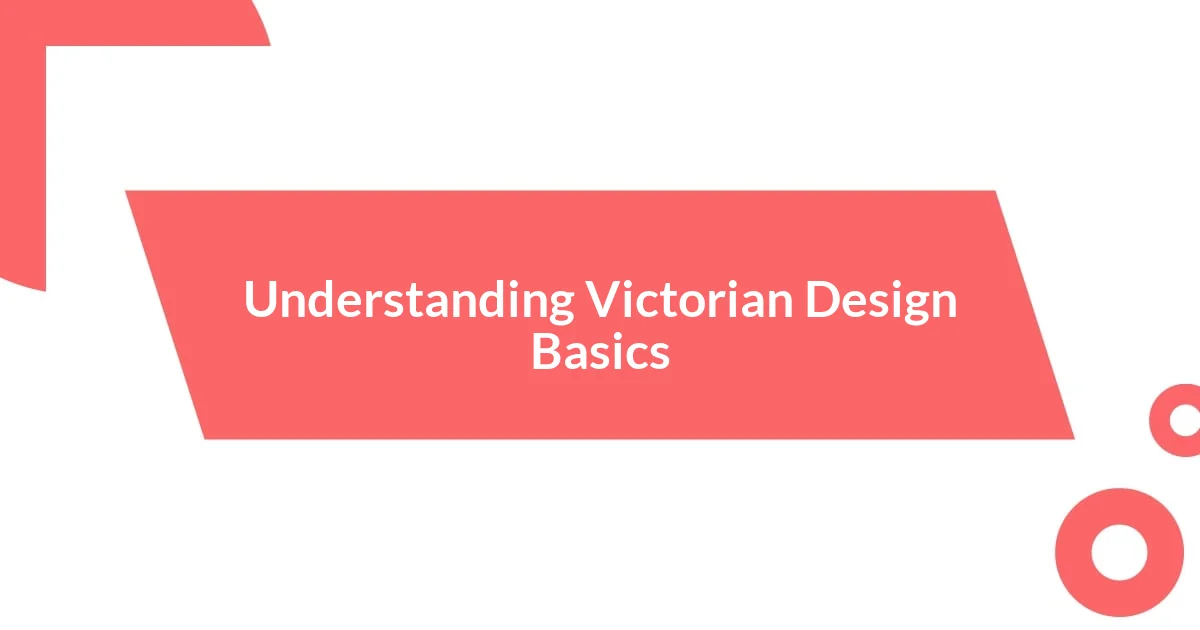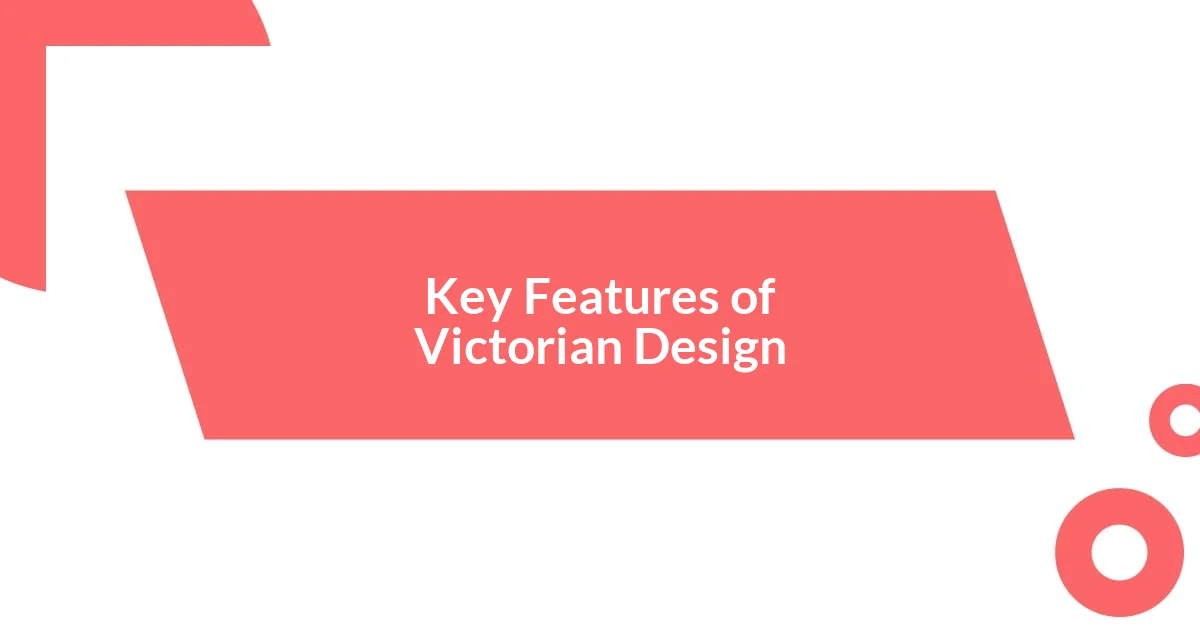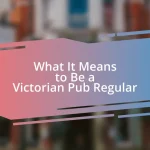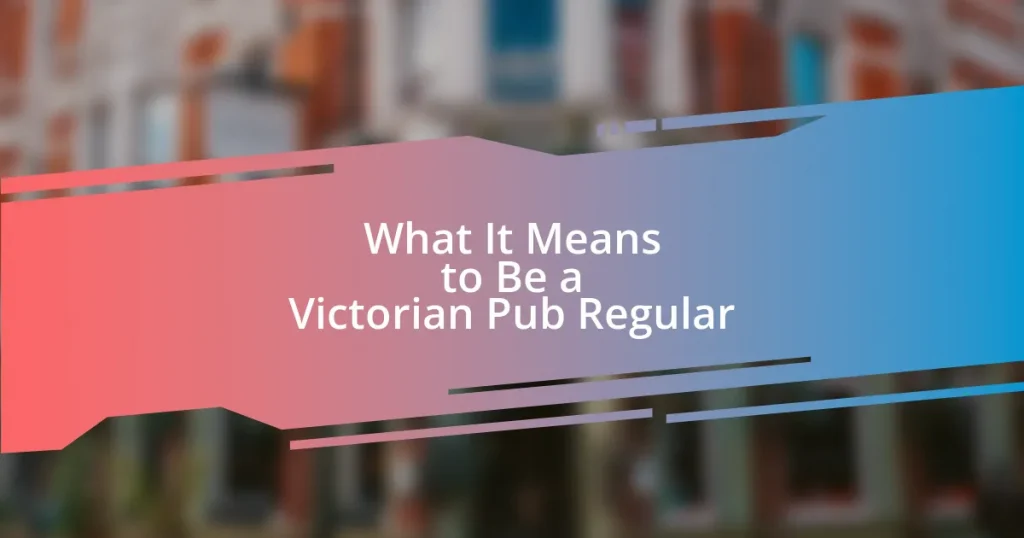Key takeaways:
- Victorian design, prominent from 1837 to 1901, is noted for its intricate ornamentation, eclectic styles, and a focus on beauty in all elements.
- Key features include ornate details, bold patterns, heavy textiles, and an abundant mix of furniture styles that create a rich, inviting atmosphere.
- Modern applications of Victorian design are seen in contemporary interiors and fashion, emphasizing the enduring appeal of historical elements in today’s aesthetics.

Understanding Victorian Design Basics
Victorian design, emerging during the reign of Queen Victoria from 1837 to 1901, is characterized by its intricacy and opulence. I remember walking through a restored Victorian home and feeling a sense of wonder at the elaborate woodwork and vibrant wallpapers that enveloped me. It struck me how every detail seemed to tell a story, sparking my curiosity about the lives of those who once inhabited those spaces.
One defining element of Victorian design is its blend of styles, drawing inspiration from Gothic, Classical, and even Asian influences. This eclectic mix was so appealing to me that I began to explore how different materials like rich mahogany and plush velvets created both warmth and sophistication. Don’t you find it fascinating how such varied inspirations can converge to create a singular aesthetic that feels both homely and grand?
Victorians placed a high value on ornamentation, believing that beauty was essential. I recall a moment at an antique fair when I stumbled upon a beautifully crafted decorative piece and realized that each curve and detail reflected the time and effort invested by skilled artisans. It made me ponder: how do these intricate designs continue to influence modern decor? The emotional connection we develop with these elements speaks volumes about our appreciation for artistry and history.

Key Features of Victorian Design
One of the key features of Victorian design is its exuberant use of color and pattern. I distinctly remember stepping into a Victorian drawing room, where vibrant, floral wallpapers enveloped the space, making it feel both cozy and dramatic. The layers of rich colors drew me in, creating an inviting atmosphere while also showcasing the homeowner’s personality.
Here are some hallmark aspects that define Victorian design:
- Ornate Details: Every surface is often adorned with intricate carvings, moldings, and embellishments.
- Bold Patterns: Fabrics and wallpapers frequently feature complex motifs—florals, stripes, and damasks—layered together.
- Heavy Textiles: Plush velvets and brocades are commonly used in upholstery to create a sense of luxury.
- Eclectic Mix of Furniture: A combination of styles often makes up a single room, incorporating pieces from different eras.
- Excessive Ornamentation: Furniture and decor pieces may include everything from gilt edges to elaborate fixtures, reflecting the Victorian ethos that more is more.
The abundance of materials and textures creates a rich tapestry that truly captures the essence of the Victorian era. I felt a sense of awe visiting a museum exhibit showcasing this style, where the interplay of light on glass and crystal fascinated me. It was a delightful reminder of how every detail, from lace curtains to grand chandeliers, contributed to an overall experience that celebrated both artistry and comfort.

Common Materials in Victorian Design
Victorian design thrives on a variety of materials, each contributing to its distinctive aesthetic. During my visits to various Victorian homes, I often marveled at the richness of materials like oak, walnut, and mahogany that dominated furniture and architectural elements. Touching the polished surfaces, I could feel the craftsmanship, as if each grain held stories of the past. It’s intriguing to think about how these woods, selected for both beauty and durability, provide a tangible link to history.
The textile choices in Victorian interiors are equally fascinating. My first encounter with lush upholstery at a vintage fair left me speechless—the heavy damasks and brocades spoke to me of opulence and comfort. I couldn’t help but imagine how these fabrics would envelop the space, making it feel alive and warm. Using velvet drapes and intricate lace curtains, the Victorians not only showcased their wealth but also their appreciation for tactile beauty, creating environments that invite touch and engagement.
Interestingly, metal elements like brass and wrought iron also found their way into Victorian design—something that truly captivated me during a stroll through a historic district. The way light danced off the intricate railings and fixtures created an enchanting atmosphere. This melding of solidity and elegance, with metals beautifully complementing wood and textiles, epitomizes the Victorian belief in a well-rounded aesthetic experience. Don’t you think this balance between different materials is what gives Victorian design such lasting appeal?
| Material | Common Uses |
|---|---|
| Wood (e.g., Mahogany) | Furniture, paneling, and moldings |
| Textiles (e.g., Velvet, Damask) | Upholstery, drapery, and wall coverings |
| Metal (e.g., Brass) | Fixtures, railings, and accents |

Influential Victorian Designers and Architects
One designer that stands out in the Victorian era is Augustus Pugin. He passionately advocated for a return to Gothic styles, believing architecture should express its purpose. I recall visiting the Palace of Westminster and feeling a transformative connection, realizing how Pugin’s designs merged utility with aesthetic grandeur. The intricate details and pointed arches spoke volumes about his belief in the majestic power of architecture; it wasn’t just about structure, but about evoking emotion and awe.
Another influential figure was William Morris, whose ideas fueled the Arts and Crafts Movement. His approach to design emphasized craftsmanship and natural motifs. I once found myself lost in a gallery of his iconic wallpapers, surrounded by whimsical flora and fauna, and felt as if I had stepped into a storybook. The vibrancy of his patterns reminded me of how nature can influence our homes, and I couldn’t help but wonder—wouldn’t our spaces feel more inviting if we filled them with such organic beauty?
Lastly, let’s not forget about the architect Richard Norman Shaw, whose work exemplified the Queen Anne style, a delightful mix of traditional and contemporary influences. Walking through a neighborhood filled with his homes, I was struck by the character and warmth they exuded. Each house felt like a welcoming embrace, showcasing his ability to blend practicality with beauty. It made me ponder how essential it is for our living spaces to reflect not just our needs but also our personalities—with design choices that resonate deeply within us.

Modern Applications of Victorian Design
Victorian design elements have found a fresh breath of life in modern interiors, often integrated into homes styled with eclectic charm. On a recent visit to a contemporary cafe, I noticed how they used rich, dark woods reminiscent of Victorian furnishings to create a warm, inviting atmosphere. The mix of plush velvet seating with ornate light fixtures transported me back in time while still feeling completely relevant today. Isn’t it fascinating how we can pay homage to the past while still indulging in our modern lifestyles?
In the realm of fashion, Victorian influences are making notable appearances, particularly in the resurgence of high-collared blouses and intricate lace details. I vividly remember attending a fashion show where models showcased modern silhouettes intertwined with Victorian flair, like flowing skirts accentuated with corset-like bodices. This combination beautifully channels a sense of romance while maintaining a contemporary edge. I couldn’t help but think, how can such historical design elements continue to resonate with us today?
Architectural details also play a significant role in modern spaces. I have witnessed a revival of Victorian-style mouldings and archways in new constructions, which adds a layer of sophistication that resonates with yesterday’s grandeur. Walking through these homes, I often find myself admiring the intricate craftsmanship that harkens back to a time of artful attention. How incredible is it that we can reshape our environments with pieces of history, bridging gaps between past and present?

Tips for Incorporating Victorian Elements
To incorporate Victorian design elements into your space, start by focusing on textiles. Imagine swathing your furniture in rich velvets or incorporating lace details into your curtains. I recall the first time I draped velvet cushions over my couch; the room instantly transformed into a cozy Victorian retreat, inviting warmth and nostalgia. It made me wonder—how often do we overlook textiles as a simple yet impactful way to evoke a particular era?
Another effective strategy is to emphasize ornate details. Consider adding intricately carved furniture or decorative cornices to your home. I remember discovering a beautiful side table at a flea market, its curvy legs and detailed inlays instantly captivating me. As I brought it home, I realized that one piece could breathe life into a room, creating a focal point that invites conversation. Isn’t it incredible how the right accents can evoke stories and emotions from the past?
Don’t underestimate the power of color, either. Victorian palettes often embraced rich jewel tones like deep greens, burgundies, and blues. When I painted my entryway a bold emerald, it felt like stepping into a different era. The vibrancy echoed the grand interiors I had admired in museums, filling the space with a regal energy. How can we embrace such bold choices to infuse our spaces with character and drama? Each color you select tells a story and sets the mood, so choose wisely!















